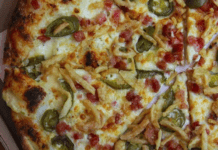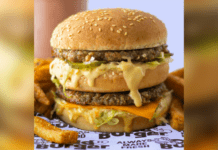Pizza and pasta are a perfect pair — but not in pandemic performance. During COVID-19, restaurant-made pasta has declined overall, likely because it travels poorly and is easy to cook at home. But pizza — long established in delivery, takeout and heat-and-eat — has been a lifeline, even for some operators who never expected to get into that market, such as the high-end Hawksworth Restaurant Group in Vancouver, which discovered an unexpected new revenue stream with an on-site and grocery-store frozen-pizza program.
Technomic’s 2021 Top 200 Chain report ranked limited-service pizza among the best-performing categories of 2020. Pizza Hut was the year’s star among Top 200 pizza chains, with six per cent growth. Pizza Pizza declined by 13 per cent, but opened 10 new locations, re-furbished others and innovated by testing beer as a beverage offering in several locations. Boston Pizza, with its strong focus on on-site dining, saw a 30-per-cent drop.
Elaine O’Doherty, Marketing manager for Ardent Mills Canada, says “value meals in Canada are up 11.6 per cent since pre-pandemic times, allowing consumers to get more bang for their buck by bundling their entrées, sides, desserts and beverages into a single-price value meal. Build-your-own value meals, in particular, are up 700 per cent.”
Technomic’s associate editor, Katie Belflower, says this holds true for pasta as well as pizza, offering examples such as Kelsey’s Original Roadhouse Pasta Bundle for Two and East Side Mario’s Penne and Meatballs Family Meal Marc-André Bazinet, director of Foodservice at Barilla Canada Inc., says he sees interest in new pasta shapes, such as Barilla’s egg pappardelle and cellentani (a.k.a. orecchiette or “Scooby-Doo”), which gives humble mac and cheese a premium feel. “Regionality in pasta shapes is also a factor in Canada,” he says. “For example, in Quebec, lasagne is much more over-indexed than the rest of the country. The same goes for mafaldine in Alberta and British Columbia, where most restaurants are using it for lasagna dishes.”
Wheatless & Meatless
The biggest movement of all is towards healthy foods, an area that was already growing before the pandemic and is now entering firmly into the mainstream.
“What was once very niche is now in the top-10 menu items, like cauliflower crust, gluten-free and plant-based,” says Robert Carter, industry expert with Toronto-based The StratonHunter Group, who adds consumers are willing to pay a higher price for greater transparency on the menu.
Technomic’s 2020 Canadian Pizza Consumer Trend Report shows that 30 per cent of consumers want healthier pizza components, and 25 per cent would consider ordering a vegetarian or vegan pizza, while 16 per cent (up from 10 per cent in 2018) would order a cauliflower crust and nine per cent would consider going gluten-free. This also translates into a trend towards thinner crusts, with only 23 per cent of consumers stating a preference for thick-crust pizza.
“Gluten-free is the top healthy claim for Canadian pizzas, at 8.1 per cent, according to Technomic’s Ignite Menu platform,” says Katie Belflower. She mentions Blaze Pizza Canada’s Keto Crust and Pizzaville and Papa Murphy’s Take ‘N’ Bake Pizza among gluten-free options.
Pizza Pizza, which was among the first of the QSR delivery brands to offer gluten-free crust, cauliflower crust, keto pizza recipes, dairy-free cheese and plant-based toppings, has launched a Superfood Crust made with purple cauliflower, purple sweet potato and butternut squash.
Though gluten-free pasta may represent a small portion of sales, “it’s becoming increasingly crucial to offer it on the menu,” says Bazinet. The plant-based craze — not just vegan or vegetarian foods, but faux meat crafted from ingredients such as soybeans and peas — now extends beyond QSR burgers. “Technomic’s Ignite Menu platform shows that plant-based cheese has grown 28.6 per cent year-over-year and that ‘vegetarian’ is the fastest-growing healthy claim for Canadian pizzas,” says Belflower.
Plant-based cheese is being accepted more quickly than faux meat. “Fewer than 10 per cent of consumers would consider ordering a plant-based alternative for bacon, sausage, beef or meatballs, for pizza,” says Anne Mills, director of Consumer Insights at Technomic.
But Pizza Nova recently introduced a plant-based pepperoni with more plant-based options set to debut in September. Pizza Hut Canada offers Beyond Meat’s Beyond Italian Sausage Crumbles. Panago Pizza has five plant-based pizzas and COBS Bread has launched a Beyond Sausage Arrabbiata Mini Pizza with Nabati Cheeze and Beyond Italian Sausage Crumbles. Two of General Assembly’s nine standard pizzas are also plant-based.
Nabati Foods Inc., which already offers plant-based cheese and ground meat, is introducing “the first soy-free, gluten-free chicken using pea protein here in Canada,” says CEO Ahmad Yehya. “We are launching a plant-based liquid egg soon.”On the pasta side, “though legume menu items like chickpea or red-lentil pasta are still fairly new, they are steadily gaining popularity,” says Bazinet.
The Ghosts & the Robots
But beyond menu planning, a key driver of success this year is the ability to take advantage of pre-existing evolutions that have been accelerated by the pandemic, such as grocery retail, ghost kitchens and digital innovation. In other words: “gone forever is the single brick-and-mortar space,” says Robert Carter.
The innovation success stories are inspiring. “We went into the pandemic as a restaurant organization, and we’re coming out as a robust omni-channel brand with grocery, direct-to-consumer lines and our restaurant,” says Ali Khan Lalani, founder and CEO of General Assembly Pizza in the Toronto area, whose pioneering frozen premium take-home pizzas and pizza subscriptions are booming. “We’re out there to take on Big Pizza,” he says.
Entrepreneur Brian Alger hopes to resurrect Mother’s Pizza, a beloved chain that once had more than 100 locations across Canada. After testing four brick-and-mortar locations in southwestern Ontario, he modified his vision to packaged goods. Now, he’s signed a distribution deal for alternative foodservice in convenience stores, gas stations, arenas and bowling alleys. “The other thing we’re looking at is a Mother’s cloud kitchen,” he says.
Carbone Restaurant Group Ltd. (CRG) in Winnipeg is an omni-channel franchise restaurant group with dreams of disrupting Canadian foodservice on a large scale. It already operates traditional brick-and-mortar brands, such as Fast Fired by Carbone, which offers customers unlimited toppings for one price. (Currently, five outlets are in operation in Winnipeg and Regina, with more planned for Ontario and Alberta later this year.) Their Veg Wedge plant-based pizza brand, which uses Modern Meats products, can be purchased as a monthly mail-order subscription.
“Now, what we’re starting to add in is our ghost kitchens,” says CRG CEO Benjamin Nasberg. He is actively seeking restaurant partners for his solar-powered shipping-container ghost kitchens. He’s also introducing robotic kitchens: “totally autonomous electric pizza kitchens inside a vending machine — 100 per cent touchless. We’ll be franchising those as early as January.”
Similarly, REEF Technology is providing ghost-kitchen services in Toronto, Calgary and Edmonton — including parking-lot shipping-container spaces — for 10 culinary partners, including Wendy’s Canada, Via Cibo, Drunken Noodles and Mia Pasta.
Carter predicts “continued growth of the direct-to-consumer and very strategic retail partnerships. People are looking for the convenience; it’s more about bringing it to the people than the people coming to you.”
Consumers are also looking for “better-for-you options: higher quality, all natural. People have taken a pause, and they’re trying to eat food of the best quality,” says Ali Khan Lalani. Although he’s literally banking on the idea that COVID-beating alternative food-delivery options are here to stay, he also predicts that people will flock back to restaurants as dining rooms re-open, because “being able to eat a hot fresh pizza out of the oven — there’s nothing like it.”
Written by Sarah B. Hood

















